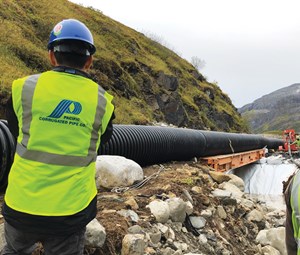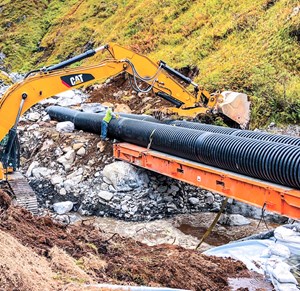May 2020 Vol. 75 No. 5
Features
Corrugated Pipe Provides Path for Increased Hydro-Electric Power
Isolated Alaska Project Takes Industry Honor
Instead of letting melting snow flow into the ocean, a plan was developed to utilize the water to increase the output of a hydropower plant in Kodiak, Alaska, by 33 million kilowatt-hours a year. To do this, a 1.2-mile-long, 11-foot-diameter tunnel is being bored through a mountain to connect the Upper Hidden Basin Creek and Terror Lake.
For diverting snowmelt flowing from the upper mountains and into the tunnel, nearly a mile of corrugated high-density polyethylene (HDPE) pipe is being used. HDPE double-wall pipe is highly efficient due to the low friction factor of its smooth interior, resulting in optimum hydraulic flow design.
Kodiak Island is not connected to the North American power grid, so renewable energy sources are critically important and highly desired in order to minimize environmental impact. The increased capacity resulting from the Terror Lake Upper Hidden Basin Diversion project represents an equivalent of $4.6 million worth of annual diesel generation, which equates to reduction of approximately 530 tons of NOx and 26,000 tons of greenhouse gas into the atmosphere.
Due to the remote location, the contractor recommended the HDPE corrugated dual-wall pipe with watertight bell and spigot ends including gaskets. The project also used HDPE corrugated single-wall pipe, fittings, couplers and HDPE flared end sections. In total, the project consisted of 5,160 linear feet of corrugated HDPE pipe.
Honor
The Kodiak undertaking was named Project of the Year in the Plastics Pipe Institute’s (PPI) Drainage Division for HDPE pipe supplier and PPI member, Pacific Corrugated Pipe Company (Newport Beach, Calif.).
Started in 2018, the Terror Lake Upper Hidden Basin Diversion Project has taken several summers to complete and will add 25-percent more energy to the facility, which now serves some 6,000 customers. Full commercial operation is scheduled for late 2020.
The Terror Lake Hydroelectric Facility is the primary source of energy supply and the cornerstone to a renewable wind-hydro energy generation system. When constructed in the 1980s, the facility included three watershed diversions that supply water to the hydropower system in addition to the Terror Lake reservoir.
A fourth watershed diversion, the Upper Hidden Basin Diversion, was part of the original plan, but not built due to the added expense and because the community did not need that power resource 40 years ago. It was, however, recommended as a cost-effective way to add generating capacity to the Terror Lake plant when the area’s growth justified it.
The Upper Hidden Basin Diversion Project follows a vision to maintain 98 percent of kilowatt-hour usage from cost-effective and renewable power solutions. As power demand grows, expanding and enhancing the existing renewable portfolio of hydroelectric and wind energy sources on Kodiak Island becomes critical. Generating green power from local sources has kept electric rates on the island relatively stable.
Runoff from the annual snowmelt in the Upper Valleys of Kodiak historically flowed away from the hydropower-generating reservoir at Terror Lake and into the ocean. To circumvent a mountain between the Upper Valleys and Terror Lake, construction companies were contracted to build a 1.2-mile tunnel connecting the Upper Valleys and Terror Lake reservoir.
Most of the pipe, up to 48 inches in diameter, will be used to permanently divert snowmelt stream water underground and towards the tunnel. Some of the pipe and accessories were also used to build cross drain roadway culverts, improving vehicle access to the dam, tunnel locations and Upper Valleys. Nearly a mile of the pipe was used.
Savings
Initial savings for the diversion project came as a result of converting from concrete pipe to HDPE, which greatly reduced material and freight costs. The pipe, manufactured at Hubbard, Ore., and accessory materials were hauled on 18 truckloads to the Seattle docks, barged to Anchorage, reloaded onto smaller ocean freight carriers, sent to Kizhuyak Bay, unloaded and transported via remote gravel roads to the project site Kodiak Island, 250 miles from Anchorage, which is accessible only by sea and air.
“Transporting goods to distant and remote areas is not an easy task,” observed Daniel Currence, P.E., director of engineering for the drainage division of PPI. “The relative light weight of the corrugated HDPE pipe and the ability to nest several diameters of pipe on one truckload was a prime advantage for this project. Hauling the same 5,000-plus feet of reinforced concrete pipe would have been nearly logistically and economically impossible.”
Currence discussed the properties of the pipe. “An additional benefit of the HDPE pipe is its sustainability. The HDPE material will not corrode, rust or degrade due to biological attack, so the pipe resists bio-clogging and will be able to maintain high and consistent flow capacities over the service life of a system.
“This plastic pipe system is a sustainable and environmentally responsible choice that will serve generations to come. HDPE pipe is strong, durable, light, flexible and ecologically friendly during manufacturing because it requires significantly less energy to fabricate, transport and install than metal or concrete pipe.
Its resiliency, with superior resistance to corrosion and abrasion, also supply long service life and excellent joint performance –
all adding up to exceptional value,” he stated.
“The people in the surrounding Kodiak, Alaska community will benefit from an increase in renewable power supply,” Currence summed up. “This project is supporting the reduction of a carbon footprint in a sensitive area of Alaska, while also helping to provide additional resources to the island and allow for future growth.” •






Comments